After all, the right stuff was not bravery in the simple sense of being willing to risk your life (by riding on top of a Redstone or Atlas rocket). Any fool could do that (and many fools would no doubt volunteer, given the opportunity), just as any fool could throw his life away in the process. No, the idea (as all pilots understood) was that a man should have the ability to go up in a hurtling piece of machinery and put his hide on the line and have the moxie, the reflexes, the experience, the coolness, to pull it back at the last yawning moment.
-Tom Wolfe, The Right Stuff
Instant cultural icons. American heroes. The best of the best. Those are just a few of the superlatives associated with the seven men that NASA introduced to the country 60 years ago this week: our first astronauts.
The Space Race between the United States and the Soviet Union began in earnest with the launch of Sputnik on October 4, 1957. President Dwight D. Eisenhower proposed the creation of NASA; by the fall of 1958, NASA would absorb previous programs and departments dedicated to space travel, including NACA (National Advisory Committee for Aeronautics) and the U.S. Air Force’s Man in Space Soonest (MISS) effort. Then the Russians launched a second Sputnik, this one carrying a dog, Laika. It became even more of an imperative for the U.S. to get a man into space. That effort would be dubbed Project Mercury.
Mercury’s goal was to put an astronaut into space in a single-person spacecraft. The astronaut would be seated in a capsule mounted atop a rocket modified from Redstone and Atlas missiles. After achieving orbital or suborbital flight, the capsule would make re-entry and be retrieved in the ocean. Many of the functions necessary for flight would be controlled from NASA on the ground with the astronauts making adjustments and performing other tasks in flight. Despite an abundance of caution undertaken by expert engineers, this kind of mission would obviously still be extremely dangerous. How do you recruit for that?
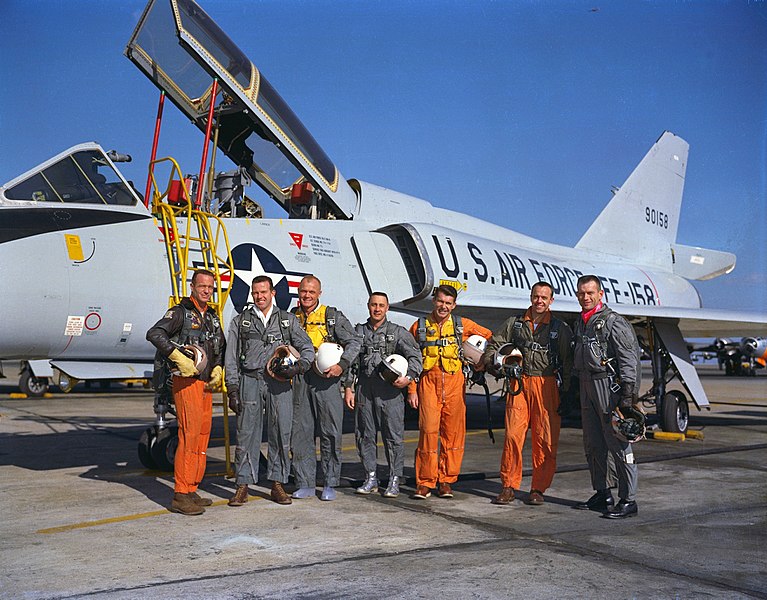
NASA decided to use military test pilots, both for their familiarity with operational security and their reputation for fearlessness in potentially dangerous situations. The specifications drawn up by the search committee also required that candidates possess a bachelor’s degree, be a graduate of test pilot school, and be a flight-qualified jet pilot with more than 1,500 hours of flying time logged. They also had to be in outstanding physical condition to withstand the rigors of spaceflight, notably the gravitational forces that act on the body during both the launch and re-entry phases.
More than 500 pilots comprised the first pool, which was winnowed down to 110. After Pentagon and NASA briefings, written tests, physical examinations, and adherence to height and age requirements, the pool dropped to 32. The group experienced a variety of medical and psychological tests and physical challenges that ran from the strenuous (hours on treadmills) to the strange (candidates were given five enemas). .Robert R. Gilruth, Director of NASA’s Space Task Group, selected the final seven. The so-called Mercury Seven were Alan Shepard, Virgil “Gus” Grissom, John Glenn, Wally Schirra, Scott Carpenter, Deke Slayton, and Gordon Cooper.
The group had a laundry list of accomplishments as military pilots; many of them flew combat missions in World War II or Korea (Grissom flew 100 combat missions during the conflict, and Schirra flew 90). Glenn had already made history by making the first supersonic transcontinental flight across the U.S. As a group, they were dizzyingly qualified. In fact, the overall candidate pool was of such a high caliber that a number of astronauts that didn’t make the first round were invited into later programs, including Pete Conrad (eventually the third man to walk on the Moon) and Jim Lovell (who famously commanded Apollo 13).
NASA formally introduced the astronauts in Washington, D.C., on April 9, 1959, to a crowd of 200 reporters. Virtually unknown, the seven men were hailed as national heroes by the next day, with the press and commentators playing up their roles as daring explorers and new leaders in an ideological race to hold the line against the Soviets in outer space. The press immediately praised the group as “ seven men cut of the same stone as Columbus, Magellan, Daniel Boone, Orville and Wilbur Wright,” but they proved to be refreshingly normal. Asked about the worst part of the medical testing, Glenn said, “If you figure out how many openings there are in the human body, and how far you can go into any one of them, you can answer which would be the toughest for you.” Their “regular guy” demeanor in terms of how humbled they were about their selection only furthered their popularity.
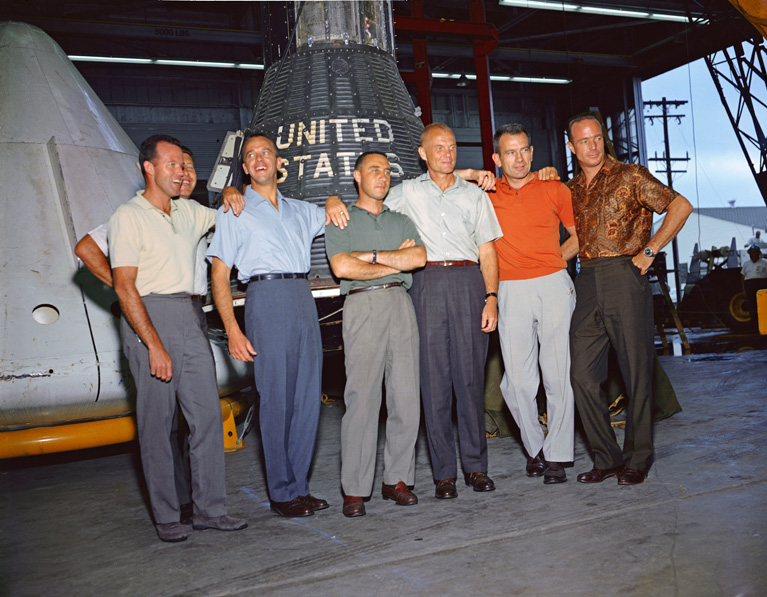
Behind the scenes, the Mercury Seven became instrumental team members for the ultimate planning and design of the missions. Despite having some of the greatest minds in aeronautics and rocketry on staff, the astronauts were welcomed in to contribute from their own areas of expertise. Each astronaut had an impact on systems and design based on their own personal experiences. Grissom, for example, held an engineering degree from Purdue University, and was involved in working on the attitude control systems. Carpenter came in with an interesting skillset that included airborne electronics and the extremely appropriate art of celestial navigation, which is the practice of using the stars to find your way; he was a natural for taking responsibility for the communications and navigation systems.
The Mercury Seven and the “space race” became an ongoing source of general fascination for the next few years, bolstered in part by president John Kennedy’s enthusiasm for the program and his vision of a “New Frontier.” Alan Shepard was selected to be the first American in space; the U.S. might have beaten the Soviets on that front, but Shepard’s mission was plagued by delays. On April 12, 1961, cosmonaut Yuri Gargarin made the journey first, and also became the first man to orbit the Earth. Shepard finally got the go-ahead on May 5, 1961, and became the second person, and first American, in space.
Over the years that followed, the Seven continued to make their mark at NASA. Grissom unfortunately died in the launchpad fire that occurred on Apollo 1, but the other six lived into the 1990s and beyond, taking part in acts of bravery and distinction. All of the men eventually made it into space, with some going multiple times. Cooper was the last man to fly in space alone. Shepard went to the Moon as commander of Apollo 14. Glenn flew on Space Shuttle Discovery at the age of 77 while he was a sitting U.S. Senator. Carpenter also took part in the Navy’s SEALAB deep-ocean habitat projects. Wally Schirra flew as part of the Mercury, Gemini, and Apollo series of missions. Slayton was the first Chief of the Astronaut Office before becoming Director of Flight Crew Operations.
Tom Wolfe’s book on the space program, The Right Stuff, talks about the intangibles that reside inside the best of us. The Mercury Seven were real people, and by definition, real people can’t be perfect. But they represented a grander American ideal of trailblazing and ingenuity. They represented the triumphs of science and teamwork. If you’re ever asked to point to a person that showed what the promise of Kennedy’s “New Frontier” looked like, it’ll be easy. You’ve got seven.
Featured Image (in space suits): The Mercury Seven on April 9, 1959 (Front row, left to right: Walter M. Schirra, Jr., Donald K. “Deke” Slayton, John H. Glenn, Jr., and M. Scott Carpenter; back row, Alan B. Shepard, Jr., Virgil I. “Gus” Grissom, and L. Gordon Cooper, Jr.) (NASA)
Become a Saturday Evening Post member and enjoy unlimited access. Subscribe now
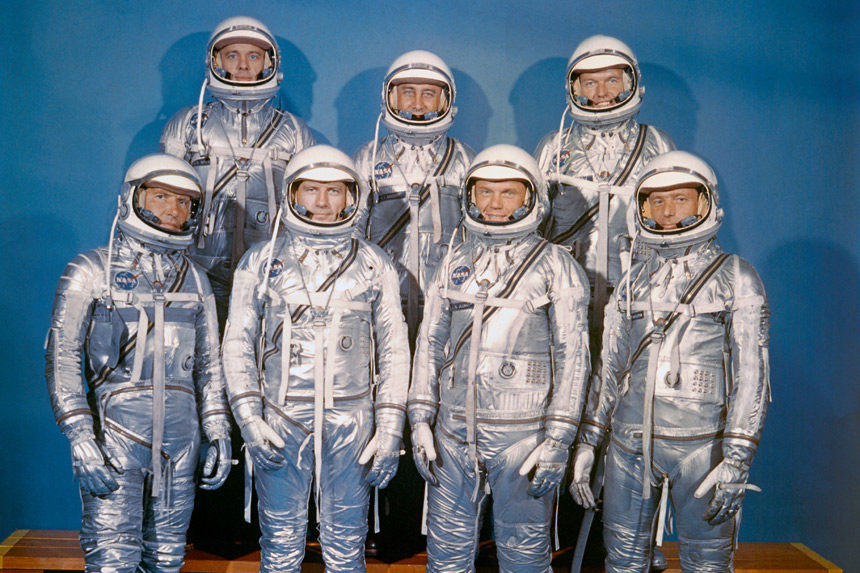
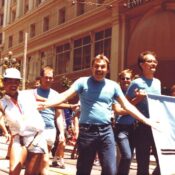
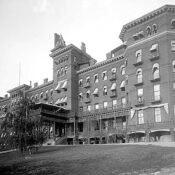
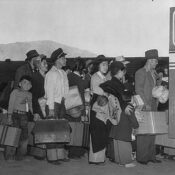
Comments
These are just a few of the superlatives that were associated with the seven men that NASA introduced to our country on April 9,1959 the first American astronauts.
It’s great to see the Mercury Seven pioneering astronauts being honored by the Post on this 60th anniversary week of their setting the stage for the U.S. Space Age successes of the ’60s.